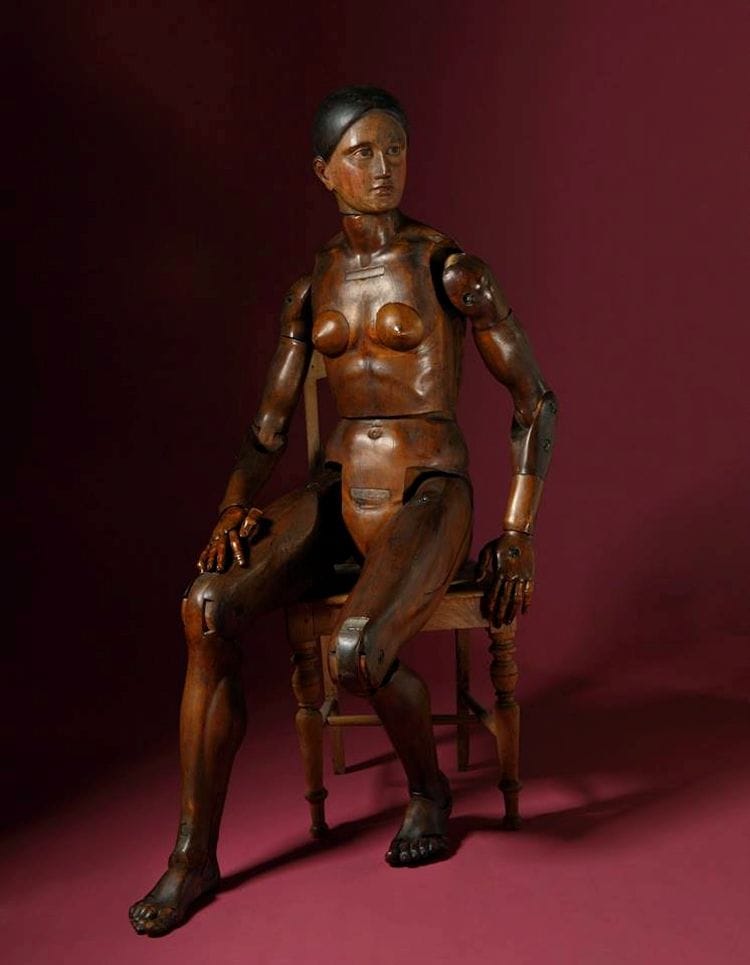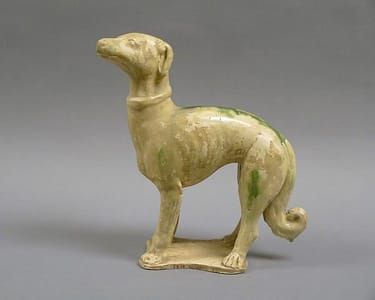

Mannequin Articulé
Unknown
circa 1800
Wood, probably walnut, metal hardware, fully articulating with peg and ball joints and moveable fingers, removable breasts and painted head and face,
height: 67 in.
Wooden mannequins, also known as lay figures, have been an ever-present element in artist’s studios since at least the Renaissance, found in the ateliers of Michelangelo, Titian, Edgar Degas, Giovanni Boldini and Gustave Courbet among countless others. These obliging and indefatigable models were used to study the figure, with its skeleton and musculature abstracted into geometric forms, and, perhaps more commonly, to recreate the drape of clothing or fabric and the resulting fall of light and shadow over the human form; in fact, the verb “manniquer” first appears in 18th century France and is used to describe the act of artfully draping cloth over a mannequin to a natural effect (Jane Munro, Silent Partners: Artist and Mannequin from Function to Fetish, Fitzwilliam Museum, Cambridge, October 14 2014 – January 25, 2015, exh. cat. p. 28).
By the end of the 18th-century, demand from artists for accurately proportioned and fully articulating figures was so great that mannequin–makers went to ingenious and extraordinary lengths in order to engineer objects that are works of art in themselves.
These mannequins range in size from six inches to more than life-size, and served a variety of purposes. Early surviving 16th and 17th century wooden articulated figures, almost all of which are German and Austrian and referred to as Gliederpuppe, were intricately carved to a high degree of finish and likely intended for display in a Kunstkammer (cabinet of curiosities) to reflect the “perfect human form”. As a tool in the artist’s arsenal, however, mannequins were hidden from view and rarely, if ever, included in representations of the artist’s studio – their presence hinting at the laborious act of painting and diminishing the perception of the artist as inspired genius (Munro, p. 2).
By the 19th-century, when the present mannequin was likely produced, Paris was home to the leading ateliers producing the most elaborate and lifelike mannequins articulés. Built around a clever skeleton of wood peg and ball joints and metal fasteners which can be posed in multitude ways, the body of these mannequins was most often soft and shaped out of horsehair, wax, silk, cotton and painted papier-maché. In the present model, hardwood has been beautifully hand-planed and defines the musculature of the body, evident in the calves, forearms, the naturalistic rib cage with its clavicles and neck muscles clearly rendered, overlapping the pelvis to hide mechanical elements beneath and creating a rare naturalistic effect. Also unique are the classically proportioned and serene painted face, implying that the mannequin is of French origin, and the removable breasts which allow it to play the role of either gender.
This tactile simulation of the human body has a startling and sensory effect, even on present-day viewers. Certainly, the distinctly gendered Gliederpuppe, with their carefully rendered anatomy, imply an erotic appeal for collectors, while 20th century and contemporary artists have treated mannequins as subjects rather than stand-ins (Munro, p. 35-6). Indeed, Surrealist artists like Salvador Dali, Giorgio Di Chirico, Hans Bellmar and Man Ray all exploited this subject to create potent narratives and amplify the psychological friction in their work, a tradition continued by the prosthetics of Cindy Sherman and Jake and Dinos Chapman.
The present mannequin articulé is a rare and exceptional example of an essential component of the 19th century artist’s studio, and yet it transcends its functionality and compels reflection on how images are constructed and the body is represented.
[http://www.sothebys.com/en/auctions/ecatalogue/2014/19th-century-european-art-n09218/lot.1.html]
Uploaded on Jun 9, 2018 by Suzan Hamer
Unknown
artistArthur
Wait what?











